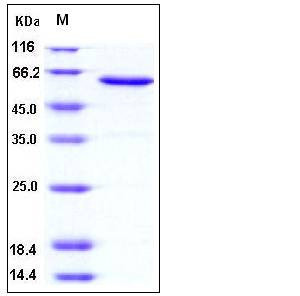Human JAM-A / F11R Protein (Fc Tag)
CD321,JAM,JAM1,JAMA,JCAM,KAT,PAM-1
- 100ug (NPP2285) Please inquiry
| Catalog Number | P10198-H02H |
|---|---|
| Organism Species | Human |
| Host | Human Cells |
| Synonyms | CD321,JAM,JAM1,JAMA,JCAM,KAT,PAM-1 |
| Molecular Weight | The mature recombinant human JAM-A/Fc chimera is a disulfide-linked homodimeric protein. The reduced monomer comprises 453 amino acids and has a calculated molecular mass of 50 kDa. As a result of glycosylation, the rh JAM-A/Fc monomer migrates as an approximately 61 kDa protein in SDS-PAGE under reducing conditions. |
| predicted N | Ser 28 |
| SDS-PAGE |  |
| Purity | > 95 % as determined by SDS-PAGE |
| Protein Construction | A DNA sequence encoding the extracellular domain (Met 1-Ala 242) of human JAM-A (NP_058642.1) precursor was expressed with the fused Fc region of human IgG1 at the C-terminus. |
| Bio-activity | Measured by the ability of the immobilized protein to support the adhesion of Jurkat human acute T cell leukemia cells. When 8 x 104 cells/well are added to JAM-A-Fc coated plates (2.5μg/mL, 100 μL/well)in the presence of 20 ng/mL PMA, approximately 30-40% will adhere after 30 minutes at 37℃. |
| Research Area | Cardiovascular |Blood |Platelet |
| Formulation | Lyophilized from sterile 100mM Glycine, 10mM NaCl, 50mM Tris, pH 7.5 1. Normally 5 % - 8 % trehalose, mannitol and 0.01% Tween80 are added as protectants before lyophilization. Specific concentrations are included in the hardcopy of COA. |
| Background | Junctional adhesion molecule-A (JAM-A), also known as F11 receptor (F11R) or Cluster of Differentiation 321 (CD321), is a transmembrane protein expressed at tight junctions of epithelial and endothelial cells, as well as on circulating leukocytes. JAM-A protein serves as a serotype-independent receptor for mammalian orthoreoviruses (reoviruses). It is also a ligand for the integrin LFA1, involves in leukocyte transmigration. As a cell adhesion molecule of the immunoglobulin superfamily, JAM-A protein involves in platelet adhesion, secretion and aggregation, and plays a crucial role in inflammatory thrombosis and atherosclerosis. In addition, it may be a potential therapeutic target for breast cancer. |
| Reference |
